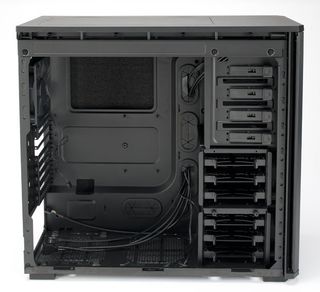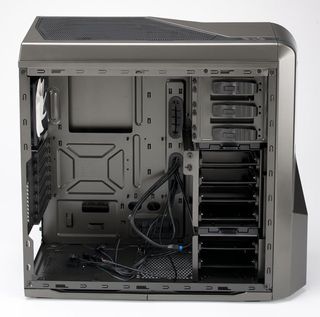Mid-Tower Review Roundup
Corsair Obsidian 550D
The sound of silence (and the heat, too)

Corsair’s Obsidian 550D comes packed with sound-dampening acoustical foam (nearly half an inch on its side panel), but it’s not just Corsair’s dedication to quiet that has us wowed. It’s the 550D’s interactivity: Gaining access to most of the steel case’s fan mounts (two 12cm mounts on the top, two preinstalled 12cm fans on the front, and two 12cm fan mounts on the case’s side) only requires you to push on a panel. Out it pops and in you go. The case’s side panels receive a similar treatment: Just hit a button on the rear of the case and bam—you can take them right off.
Corsair continues this “touch” motif on the case’s inside, where there’s room for you to install four 5.25-inch devices (that automatically lock into place) and up to six 3.5-inch hard drives (using drive trays). PCI components require you to deal with thumbscrews. Not the best way to go about it, but one that’s better than normal screws at least.

This system covers the inside of each panel in acoustic foam, but you’ll pay a price for the lessened noise.
We have to call out the Obsidian’s excellent cable-management techniques. Four rubberized holes and two normal holes give you easy means for stringing and concealing cables —like the big one for the 550D’s two front-panel USB 3.0 ports. Since the actual space for an ATX or microATX motherboard is recessed on the tray, the flip-side delivers plenty of recessed space for aligning your cables. We love this bit, since mashing a ton of cables between the flat back of a motherboard tray and the case’s side panel is never a fun task.
While we like that this foam-filled case cuts down on noise, the 550D will get hotter than most cases on the inside, and it’s a bit heavier than you might expect. Perhaps Corsair could have alleviated its cooling issue by using larger fans.
Dragonglass
PC Gamer Newsletter
Sign up to get the best content of the week, and great gaming deals, as picked by the editors.
Quiet; great concealment of adjustable areas; recessed motherboard tray.
Quartzite
Heavier and warmer than your average case.

$160, www.corsair.com
NZXT Phantom 410 Gunmetal Edition
One of the best-looking mid-towers on the market

The Phantom 410 inherits the good looks of its full-tower predecessor but adds some tweaks of its own. It’s a great-looking case in any color (we’ve used white and red for builds), but the gunmetal gray is spectacular. The paint is thick and luxurious to the touch, enough to give the Phantom 410 a much better feel than the MSI Ravager, which uses similar chassis tooling. Like the full-tower Phantom, the 410 has plastic shrouds on the top and front panels, which increase the size of the case (and make it impossible to rest anything on top). The top shroud contains two USB 3.0 ports, two USB 2.0 ports, audio jacks, and a three-speed fan controller—as well as the seven fan-control cables that lead from it.
The Phantom 410 hides three 5.25-inch drive bays behind a front-panel door, and has six drive trays. The top four drive trays are in a removable cage with an adjustable fan mount on it.
The case ships with 12cm front and rear fans and a 14cm top fan, with room for another 12cm front fan, 12cm or 14cm top fan (or 240mm radiator), two fans on the side, and one on the bottom.
Half of the motherboard tray’s six cable cutouts are grommeted, though the grommets tend to fall out at a moment’s notice. The mobo tray, per today’s standards, includes a large CPU cooler cutout. There’s plenty of room for cable routing behind the mobo tray, which is good, because otherwise the welter of fan cables would be really annoying.

We like the fan controller, but don’t dig the tangle of cables it requires.
Our other gripe with the Phantom 410 is not unique to that case: It shares the Switch 810’s drive trays, which have the SSD mounting holes the wrong way around—annoying, but not fatal. At just $100 for a solid, great-looking case, this is a steal.
Fandom
Great looking, great cooling, lots of fans.
Weird HDD
trays; tangle of cables.

$100, www.nzxt.com
Most Popular





